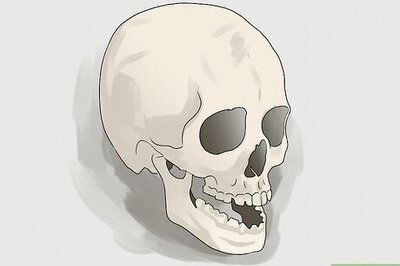
views
THIRUVANANTHAPURAM: Making a few dark brown strokes using a painting brush dipped in the milk of ‘vengai’ tree, Balasubramani is giving final finish to a painting depicting the joyous moments among the tribes. He is following a rich tradition of ‘Kurumba’ painting that according to him dates back to more than 2000 years and is carried over through generations. As he explains further, it becomes evident that the art had its origin with an age old tradition that they still follow closely.Kurumbas are the tribes who live inside the caves on the Nilgiris in Tamil Nadu whose major activity is agriculture. As they live inside a natural dwelling and their major livelihood is cultivation, ‘Kurumbas’ observe a festival for seven days every year to please the Gods and for the prosperity of their village.“During the festival, the Gods enter the body of one among us and he draws pictures on soil, signifying the good and evil that are likely to happen in our village. Those drawings paved the way for this art form,” says Balasubramani.Having come all the way from Nilgiris to the city, he has displayed his works at the pavilion of TRIFED for Santhigiri fest organised by Santhigiri Ashram at Pothencode.The poojas are performed on all seven days of the festival. The major threats that are likely to affect the crops, like the attack of wild elephant or natural calamities are predicted in the drawings. As per the nature of the ominous symbols, the villagers stay alert to prevent them. As time progressed, the Kurumbas make temporary shelters to reside instead of living in caves.The Kurumba paintings are done using natural colours on hill surfaces as per tradition. Major colours that are used for the paintings are black, brown, yellow and green. The sources for making these natural colours are the barks of the trees, green leaves and cowdung. For convenience, the present generation depend on artificial colours to draw.But he says the hard work that goes behind bringing in the ethnic charm on the works is not a cakewalk. “It takes a whole day to complete a painting using natural colours. As the size increases, the work would consume up to four days,” says Bala pointing to a large painting that hangs on the wall.The price is also a bit higher for the ones that are done using natural colours- as it is priced at Rs 400 a piece whereas the pieces made in water colour are available at Rs 300. It is on handmade paper that the paintings are drawn.The subjects that are selected for the art include the tribal dance forms, festivities surrounding marriage ceremonies and the routine life of the tribes. Apart from beautiful pieces for home decor, Kurumba art appears on book marks, bags and T-shirts also.

















Comments
0 comment